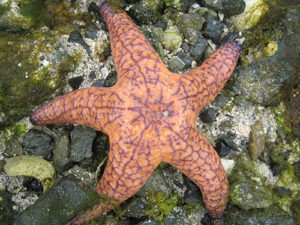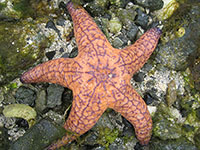— from Russel Barsh, KWIAHT —
More than 500 people visited two-acre Indian Island over the long Fourth of July holiday weekend, many of them taking advantage of the opportunity to observe an annual bivalve census that measured nearly 800 clams and cockles, and bimonthly seining of fish in the island’s extensive eelgrass meadows.
Volunteers continued to discourage visitors from climbing from tide pools to the summit of the island, where rare Black Oystercatchers are raising their first chick in four years. The fluffy charcoal gray chick, nicknamed Izzie by the Kwiaht science team, could be seen following its parents learning how to pry tasty limpets and mussels from rocks on the island’s southeast point. Volunteers expressed relief that Izzie survived the fireworks display nearby, and estimates that the chick will be relatively independent in a few weeks, although it will probably follow its parents on foraging trips far from Indian Island during its first winter.
 The island’s colorful Ochre Stars, still gradually recovering from an outbreak of wasting syndrome (SWS) two years ago, were not so fortunate. Just one day after Kwiaht apprentices counted 416 healthy sea stars—the highest number seen since 2013—vandals overturned more than a dozen large rocks on the south shore of the island, exposing some fifty sea stars to direct sunlight. Most were dead or badly injured when discovered by Indian Island stewards on Wednesday.
The island’s colorful Ochre Stars, still gradually recovering from an outbreak of wasting syndrome (SWS) two years ago, were not so fortunate. Just one day after Kwiaht apprentices counted 416 healthy sea stars—the highest number seen since 2013—vandals overturned more than a dozen large rocks on the south shore of the island, exposing some fifty sea stars to direct sunlight. Most were dead or badly injured when discovered by Indian Island stewards on Wednesday.
“It’s bad enough that these animals have struggled with disease for two years, but why do people feel the need to roll over sea stars’ hiding places and leave them exposed to die?” asks Kwiaht director Russel Barsh. “Most of the dead animals are juveniles, so the people that did this have set back sea star recovery seriously.”
For further information visit: indianisland.info
**If you are reading theOrcasonian for free, thank your fellow islanders. If you would like to support theOrcasonian CLICK HERE to set your modestly-priced, voluntary subscription. Otherwise, no worries; we’re happy to share with you.**









:-< Its a shame that people need a manual for nature, but clearly we do. Not that most would read it…. Perhaps Indian Island needs full time staff in the summer? Gah.
If there are low tides on a busy weekend, those are the times extra volunteers are needed.
Unfortunately folks that visit here are not interested in nature. They want to see it once, roll it over, see if it squeels, and then go play with their other toys. We are going to need to learn to quard our nature or we will loose it! Thank goodness Izzy survived! We will be working on getting a laser show for next year! Merry
Indian Island needs to be quarantined from humans, unfortunately.
It also needs protection from chemical and audio toxic fallout from the old, tired form of celebration called fireworks. Come on, people, it’s the only earth we have.
So, put a sign out that says something like:
ENTERING A WILDLIFE REFUGE. DO NOT TURN OVER ROCKS OR DISTURB NESTING BIRDS.
Paul and Merry Beth, I don’t think it’s a matter of people not being interested in nature. It’s more a matter of people not being educated…And perhaps it’s the job of those who are more conscious and aware to educate in some way those who are not.
SO DISTRESSING!!! I always make it a point to caution visitors about the area when they’re in the shop and mention going out to Indian Island…. But it doesn’t seem to help. I agree that the only way may be to close off the area entirely if people can’t learn to read and understand a giant sign.
Selective close offs seems like a good way to go, wake people up a bit.
I’d like Russel (Kwiaht) to comment on what he and his tireless volunteers are allowed to do as far as signage and restrictions goes on Indian Island, as it’s owned by National Monument/BLM folks.
Thanks.
I grew up on orcas taking field trips to Indian island- where you could roam wherever you wished and we were taught to respect the wildlife and leave it as we found it- taking my kids there now one of my favorite activities of the summer.
That being said it is not “a huge sign” that greets you as you walk up, and the volunteer there stops most people to tell them not to venture to the top, but maybe there needs to be a a few more visible and well worded signs with very explicit instructions to not travel to the top and to be careful to especially leave rocks as they were found. It would be a huge shame to not be able to visit the island and the natural aquarium I grew up learning about. I don’t agree that barring all visitors is the answer-how will anyone learn the proper way to treat wildlife? Our next generation will miss out. -maybe handing out a very simple leaflet? It is not that difficult to stay off the top, and to gently lift rocks then gently lower them back, to be respectful of sea life….
I also don’t agree canceling all fireworks is the solution. They used to set the fireworks off FROM Indian island. The barge is a good compromise. The impact not having the fireworks would be huge for the people living and working on the island. I cringe when I think of the damage fireworks do to the ocean, but it is one day to celebrate a very special moment in our country’s history- now that personal fireworks are banned it is something my family (and many others) look forward to every year.
Boy do I not want to comment on this… but I think Nicole’s sentiment is worthy of support.
My family spent at least one day of the weekend out in the Indian Island area and I can say that the result is now a general feeling in my 4 and 7 year olds that going to the beach just means you get into trouble.
Part of ecology, part of learning, part of creating a passion for nature (or anything for that matter) is experience. Part of sparking an interest in the head of a 4… 5… 18… 55 year old is to give them the ability to participate, hands-on in the experience. Obviously, we want them to do it as responsibly as possible, and encourage them to do it responsibly, but to label curiosity as vandalism seems a bit of a stretch. It is unfortunate that sea-life was damaged through careless action, but that does not mean that there was malice attached to the activity. It also doesn’t mean that interacting, hands-on with sea life is necessarily a bad thing.
This weekend when my family visited the beach, the predominant words that they were told were “you can’t”, “don’t do that”, “stay away”. Even my 24 year old daughter, who grew up playing around Indian Island, walked away shaking her head. As the tide was coming in, there were families that were actively turned away at the shore and told that they could not walk out into the tidal area because it would be too dangerous. But isn’t that what we want people to experience? Don’t we want them to see what happens as tides move, as marine life changes through tidal action? Isn’t that part of the glory of Indian Island: that it transitions from connection to disconnection with our little commercial hub? Isn’t the risk that you will get stuck, wading half-deep through the water with your toddler on your shoulders part of the experience? The experience this day was not one that encouraged positive interaction with nature, it was one the made it very clear that “This Nature” is not for you. Maybe that was the intent, or perhaps it was just the delivery, but in either case it didn’t feel right.
I am all for protecting Indian Island. I am all for encouraging responsible interactions with nature. What I am not for is turning what is a remarkable laboratory for teaching, learning and experiencing into a place that is guarded so heavily, that it loses it’s functional value. We have a chance to inspire every visitor to Indian Island to take their experience and apply it to their own, local ecosystem, but if we continue to vilify their curiosity there’s a good chance they will lose interest.
Justin – I may have been the volunteer your family met on Indian Island this weekend. My apologies if your day wasn’t what you’d hoped it would be. I’d be happy to talk to you, if you’d like to call me at 376 4344. Robyn Lowe
What Robin doesn’t say here is that the balance between human learning experience concerning a fragile island/not-an-island and protection of it is on a very thin cord. Our attempts to maintain that balance can easily be interpreted as heavy handed or overkill. The creatures and flora we are trying to protect can’t speak for themselves.
We’re just trying to help………